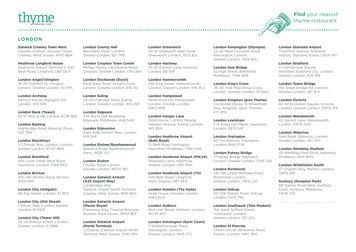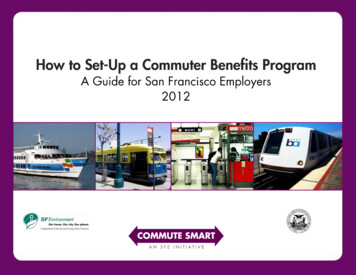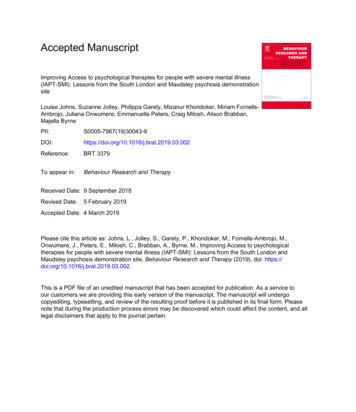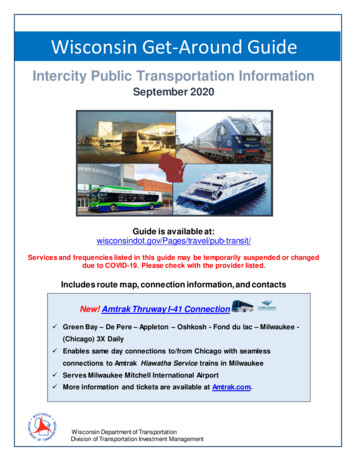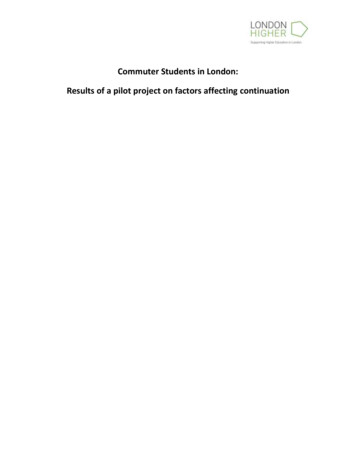
Transcription
Commuter Students in London:Results of a pilot project on factors affecting continuation
AcknowledgementsLondon Higher wishes to thank all the individuals and institutions who contributed to this report: Eglė Butt and Matt Hiely-Rayner, Kingston University LondonJethro Shaw and Dr Simon Lewis Middlesex University LondonOmar Ceron and Susan Clucas, SOAS, University of LondonAllison Peter, Kiran Bahra and Rebecca Moodie, University of East LondonKarl Molden and Dr Christine Couper, University of GreenwichJosh Costa and Konstantinos Tzortzis, University of West London.London HigherLondon Higher is the membership body representing over 40 higher education (HE) institutions inLondon. Our members range from some of the UK’s largest multi-faculty institutions to specialistinstitutions. All are linked by a commitment to excellence, serve the needs of society and students andare headquartered in London. London Higher 2019London HigherTavistock HouseTavistock SquareLondonWC1H 9JJwww.londonhigher.ac.ukCompany limited by guarantee, registered inEngland and Wales No. 05731255Registered Charity No.1114873Page 2 of 22
Contents1.2.3.4.5.6.7.SectionExecutive summary and recommendationsIntroduction and backgroundMethodology for quantitative analysesKey findingsSummaries of data analyses by project HEIsConcluding remarksReferencesPage number456792122Page 3 of 22
1. Executive Summary and recommendationsContinuation is defined as the proportion of entrants who continue their studies, with full-time studentsbeing counted between their first and second year of study (Department for Education, 2017a). It is thesingle most heavily weighted indicator in the Teaching Excellence and Student Outcomes Framework(TEF), at 25% of the metrics, but commuting or travel time is not a variable which contributes to thebenchmarking factors. Hence, higher education institutions (HEIs) with large numbers of commuterstudents need to understand how this diverse group may affect their TEF metrics. Our findings suggestnot only that students who commute in London may face barriers in their studies, but they may be lesslikely to pass their end of first year assessments, possibly also acting as an early signal in their prospectsfor retention and attainment.Using a standard analysis framework we found travel time remained a significant predictor of studentprogression or continuation for UK-domiciled full time undergraduates at three of the six Londoninstitutions participating in our study, after accounting for the expected influence of subject and otherfactors such as entry qualifications. Bimodal distributions for travel time were observed at four of theparticipating HEIs, with an initial peak between 10 to 20 minutes followed by broader profiles between40 to 90 minutes. Overall findings on student characteristics related to continuation or noncontinuation agree with a recent analysis of students in London (Petrie and Keohane, 2019).Understanding the effects commuting might have on student success may help HEIs to improve studentcontinuation, which is important given its weight in TEF and which necessitates prompt identification fortimely interventions to take place.Finally, a key main issue for this and other studies is the lack of a recognised definition for a 'commuterstudent', with the term encompassing personal characteristics and motivations, type and location ofterm-time residence, as well as travel distance or time (e.g. Maguire and Morris, 2018).Following this pilot project London Higher will seek to engage HE stakeholders, including theDepartment for Education, on the need to assess travel time for characterising commuter students andin continuation measures. We will promote the analysis framework among our members, and initiate ascoping study on commuting issues for HE staff in London with possible impacts on the studentexperience.Recommendations Adoption of the standard analysis framework by HEIs outside of the pilot project groupExtend the framework to relate travel time with attainment and/or graduate-level employmentMethods needed to study the intersectionality between factors such as travel time and ethnicityIncorporate HEI-based analyses of continuation factors in TEF benchmarks and outcomesPage 4 of 22
2. Introduction and backgroundOverview of pilot projectTo date attempts to examine the experiences and outcomes of commuter students have largely beenqualitative (Thomas and Jones, 2017). The focus of this pilot exercise was on England-domiciled fulltime first degree students in London travelling to campus whether living at home or in otheraccommodation (Maguire and Morris, 2018).Quantitative analyses at six London HEIs were carried out to determine factors affecting pass rates aftera first attempt at assessment or continuation of first year students. The participating HEIs were: Kingston University LondonMiddlesex University LondonSOAS, University of LondonUniversity of East LondonUniversity of GreenwichUniversity of West London.Commuter studentsPrevious work by HEFCE (2017) showed many students in urban conurbations stayed within the areacovered by their Local Enterprise Partnership1 (LEP) or moved to a HE provider in an adjoining LEP. Forthe London LEP nearly 58% of students stayed within the LEP region to study for a first degree. Highproportions of students remaining within a LEP were also found in Liverpool (45%), Greater Manchester(50%), Leeds (56%) and the North East (65%).Since 2014/15, annually about 90,000 students at HE institutions (HEIs) in London were from London,and comprised nearly 50% of all full-time first degree undergraduates (London Higher, 2019).Ethnicity, gender and social class were considered to be important factors for students when choosingan HEI, and students from the lowest socio-economic group were less likely to leave home for study(Donnelly & Gamsu, 2018). Other work has indicated there are four demographic groups which aremore likely to be commuter students living at home: Asian students; mature students; working students,and students who are first in their family to take up HE studies (Neves and Hillman, 2018). Thisintersectionality makes it difficult to determine which key factors could help improve their continuationand study outcomes. Students living with other students close to campus were more likely report goodvalue and satisfaction compared with commuter students living with parents or on their own (Neves andHillman, ion-map/Page 5 of 22
3. Methodology for quantitative analysesParticipating HE institutionsHE institutions taking part in the pilot study were: Kingston University LondonMiddlesex University LondonSOAS, University of LondonUniversity of East LondonUniversity of GreenwichUniversity of West London.Standard dataset and analysis frameworkA standard dataset was agreed on by the project participants, namely the annual data extract providedto HEIs in England from HESA Services Ltd., on behalf of the Office for Students (OfS), to evaluate theimpact of their financial support measures. The dataset contains continuation outcomes for Englanddomiciled full-time (including sandwich) first degree entrants, along with course and personalinformation for individual students.Several other fields were added to the datasets using a standardised coding format, including financialsupport provision, household income, entry through clearing, area of disadvantage indicators, andstudent end of year pass rates at first attempt at assessment. The cohorts for analysis varied betweenparticipating institutions but most included student entrants in 2015/16.Travel times by public transport were computed for each student using term–time accommodation andcampus postcodes, before being analysed using logistic regression with dependent binary variable beingeither pass rates at first attempt or continuation, depending on the academic rules concerning end offirst year assessments. Common factors tested for significance included travel time, gender, ethnicity,subject of study and entry qualifications. The software packages used for analyses were either Alteryx,SPSS or R.Page 6 of 22
4. Key findingsTable summarising sample cohorts and significance of progression or continuation outcomes of Englanddomiciled full-time first year undergraduates using logistic regression.Cohort(s)HEI One2015/16HEI Two2014/15 2015/16HEI Three2013/14 2015/16HEI Four *2012/13 2014/15HEI Five2015/16HEI Six2015/16No. studentrecords2,8403,5004,6905,4956752,735Travel time - -- - --Faculty/subject isadvantagedareaHouseholdincomeDisabilityst1 gen. to HE - -- --- indicates significant effect in logistic regression model at α 0.05;- indicates no significant effect;Blank space indicates not reported;* Outcomes for students aged 16-20 years old, 'Age' term is significant when all students are included.Travel timeHistograms for travel time indicated bimodal distributions at four of the six participating institutions.Travel time at these institutions had an initial peak in frequency between 10 to 20 minutes then broaderprofiles between 40 to 90 minutes. Median travel times varied between 40 to 60 minutes depending onthe institution.Page 7 of 22
Time spent commuting between term-time address and campus was found to be a significant factoraffecting progression or continuation for full time first year undergraduates in three of the sixinstitutions. At one HEI the likelihood of continuation dropped by 0.63% for every 10 additional minutestravelled. At another HEI likelihood to progress after the first attempt at assessment diminished by 1.5%for each 10 minutes of commuting.Commuting, subject of study and ethnicityThree institutions described a combination of recruitment at a national level in subjects such as creativearts, and local recruitment in subjects such as business studies. Nationally recruited students were morelikely to be white, under 20 years old, from traditional HE backgrounds, with A level qualifications andwere living in halls of residence near campus. Locally recruited students were more likely to be fromBAME backgrounds and residing further away from campus. During 2017/18, BAME students made up48% of all UK students in London, compared with 19.5% of UK students at all other HE providers outsideof London (London Higher, 2019).Four institutions reported that students from BAME backgrounds were less likely to pass at the firstsitting or continue at four institutions compared to white students. At one institution Asian studentsshowed consistently higher continuation rates than all other ethnicities, and another institutionreported ethnicity was not a significant predictor for continuation.Other characteristicsDisadvantage: It is unclear whether students are less likely to progress if they are residing indisadvantaged areas, assessed using either POLAR, Index for Multiple Deprivation (IMD) or acombination of measures.Gender: Female students were more likely to progress or continue their studies compared with malestudents at four of the six participating institutions.Entry qualifications: Students with BTEC qualifications rather than A levels for entry or who arrivedthrough clearing were significantly less likely to progress at three institutions.Disability: Students with a reported disability were less likely to progress at two institutions.Page 8 of 22
5. Summaries of data analyses by project HEIs5.1Summary outputs for HEI OneDescriptive statistics for travel timesA histogram of student travel times showed a bimodal distribution with a peak at around 10-20minutes and then at around 60-80 minutes (Figure 1) with the median commute time of 57minutes (M 54.3 min, SD 36.5 min).Figure 1. The distribution of travel time to campus in minutes for 2015/16 full-time firstdegree entrants.Main findings from logistic regression1. Accounting for the individual effects of the 11 control factors in the model, travel timesignificantly predicted student progression outcomes at first attempt. The resultssuggested that with each 10 minutes of commute, the likelihood to progress after thefirst attempt at assessment diminished by 1.5%.2. Subject of study and entry through clearing were significant predictors of student passrates at first attempt.3. Entry qualifications were the strongest predictor of student pass rates at first attempt,all else being constant. Specifically, the results suggested that the likelihood to progressafter a first attempt at assessment was significantly lower for students with BTEC as thehighest qualification on entry relative to students with ‘A’ level qualifications.Page 9 of 22
Figure 2 Marginal effect plot of student commute in minutes.4. Black students and those from mixed or other ethnic backgrounds had a significantly lowerlikelihood of early pass rates relative to white students.5. Males had significantly lower chances to pass at first attempt relative to females.6. Clearing entrants were 17% less likely to pass at first attempt relative to students who didnot enter through clearing.7. Student age or being the first in the family to attend HE did not significantlypredict the ability to pass at a first attempt.8. Students from disadvantaged areas (neighbourhoods under-represented in HE;POLAR3 quintiles 1 and 2) and those within the multiple deprivation quintiles 1and 2 were significantly less likely to pass at first attempt.9. Low household income initially predicted a lower likelihood to pass at first attempt,but the effect was no longer significant after including the financial support factor intothe model. Receiving financial support increased the likelihood to pass by 13.5%.10. Students with a learning difficulty or other disability were significantly less likely to pass at afirst attempt relative to their peers who did not report a disability.Page 10 of 22
5.2Summary outputs for HEI TwoDescriptive statistics for travel timesTravel times for students showed a bimodal distribution (Figure 3). A large group of students werefound to have commutes of 10 minutes or less and another group of students experienced commutetimes of around 40-50 minutes. The median commute time was 43 minutes (M 41 min; SD 32 min).When splitting travel times by Faculty and different demographic dimensions, several patterns begin toemerge (Figure 4): Fifty percent of students in Faculty 4 have travel times of six minutes or less.Travel times for students who were 20 years old or less on entry have a median of 42 minutes,while median travel time for students 30 or older was 53 minutes.Half of all white students have travel times of 25 minutes or less, while three quarters of ourBME students have travel times of greater than 25 minutes.Travel times by IMD quintile show that students from areas of greater deprivation have longertravel times than those from the least deprived areas.Figure 3. The distribution of travel time to campus in minutes for 2014/15 and 2015/16 fulltime first degree entrantsPage 11 of 22
Figure 4 - Distribution of travel times by Faculty and demographic factorsMain findings from logistic regression model1. Accounting for the effects of the control factors in the final model, travel time was not foundto be a significant predictor of progression.2. Progression varied significantly between Faculties with students in one Faculty showing ratesof progression at first attempt 11-13 percentage points lower than students in otherFaculties.3. Students of black and minority ethnic backgrounds were significantly less likely to progressat a first attempt relative to white students.4. Male students were significantly less likely to progress compared with female students by sevenpercentage points.5. Clearing entrants were less likely to progress than those students who enter via main cycleapplications.6. Students entering at 21 years or older were less likely to progress than younger students.7. Students whose home address is located in more deprived areas (as measured by the Indexof Multiple Deprivation) are less likely to progress than students from less deprived areas.8. Students with a reported disability were significantly less likely to progress compared with thosewithout a reported disability.9. Being the first in the family to attend HE did not significantly affect progression.Page 12 of 22
5.3Summary outputs for HEI ThreeDescriptive statistics for travel timesThe distribution of commute times followed a similar pattern across the three cohorts studied, with avery large single peak at about 20 minutes and a smaller, broader peak around 60 minutes (Figure 4).The median commute time was 50 minutes (mean 52.5 min; SD 30.7 min).Figure 5. The distribution of travel time to campus in minutes for full-time first degree entrantsMain findings from logistic regression model1. There were no differences in continuation for student cohorts in 2014/15 or 2015/16compared with students in 2013/14. Travel time was found to have a significant effect onlikelihood to continue. After controlling for the other variables in the model the likelihood ofcontinuation dropped by 0.63% for every 10 additional minutes travelled.2. Continuation was affected by subject area.3. The majority of students enter the university with BTEC or other vocational qualifications astheir highest qualification. Compared to this group only those who entered with Accessqualifications were significantly more likely to continue and only students who entered withprior HE experience were less likely to continue.4. Black students were significantly less likely to continue compared to white students but no othersignificant difference between ethnic groups were found.Page 13 of 22
Figure 6. Effect of travel time on likelihood of continuation with 95% confidence intervals5. Female students were significantly more likely to continue their studies than male students.6. Students who entered through clearing were significantly less likely to continue compared tothose who entered through the main application cycle.7. Students aged 21 to 24 on entry to the university were significantly less likely to continue totheir second year compared to students aged 20 or under. There was however no significantdifference between other age groups.8. Students in quintile 2 of POLAR3 were more likely to continue compared with students fromquintile 1 but there were no differences with other quintiles.9. Of those students who had provided evidence of their household income to the Student LoansCompany, there was no difference in continuation between those who had household incomesabove 25,000 p.a. and those below 25,000. There was, however, a significantly lowerlikelihood of continuation for those who had provided no evidence of household income to theStudent Loans Company.10. Students with a reported disability or with prior family experience of HE were not significantfactors for in continuation.Page 14 of 22
5.4Summary outputs for HEI FourDescriptive statisticsThe dataset consisted of three cohorts from 2012/13 to 2014/15. Around half of students lived 50-90minutes from campus (Figure 8), with the majority of these living in their parental home. The mediancommute time was 63 minutes (mean 60.6 min; standard deviation 27.8 min).Figure 8. The distribution of travel time to campus in minutes for full-time first degree entrantsMain findings from logistic regression modelFor the regression models, younger (16-20 years old) and mature (21 years or older) students wereanalysed separately for several reasons. Mature students in these cohorts tended to have much worsecontinuation rates than their younger counterparts. The decrease in their continuation rates as traveltime increases is also much more linear than for younger students, whose continuation rates firstdecrease and then pick up sharply around 80 -120 minutes.Younger students1. Travel time was a negative and statistically significant indicator of continuation, with a oneminute increase in travel time corresponding to a 0.6% reduction in the odds of a studentcontinuing. However, given the erratic manner in which continuation rates change as traveltime increases for younger students (Figure 9), this interpretation is slightly problematic.2. Belonging to one School was a positive indicator overall for continuation for the cohortsstudied. However, school continuation rates varied considerably year on year.Page 15 of 22
3. Students entering with A level qualifications as opposed to BTECs was a strong predictor ofcontinuation.4. With all other factors taken into account, being of Asian ethnicity was a highly significantindicator of continuation. Young students of black ethnicity were also slightly more likely tocontinue compared with white students.5. Male students were less likely to continue compared with female students. Other analysis showsthat this relates to ethnicity, with the gender gap being much wider for non-white ethnicities.6. Not giving the university household income information was a negative indicator ofcontinuation, and this is likely to relate to other factors unquantified in the model. Those withhigher household income performed slightly better than those with low income.7. Having a disability, entering university through clearing or residing in disadvantaged areas (IMDdecile 1 or 2 or POLAR quintile 1 or 2) had little impact on continuation with other factors takeninto account.Mature students1. Travel time was also a significant negative indicator of continuation for mature students with aone minute travel time increase corresponding to a 0.6% reduction in odds of continuing.2. Studying in one of the Schools was also a significant indicator for non-continuation.3. Non-white students had much lower levels of continuation for these academic years, and beingof black, mixed, other or unknown ethnicity were negative indicators of continuation rates.4. Unlike the findings with younger students, mature students residing in areas with low IMDand/or low POLAR scores were significantly less likely to continue from their first year of studies.5. Gender was not a significant predictor for continuation.6. As with younger students, disability had very little impact on continuation rates.Page 16 of 22
Comparing travel times between young and mature studentsFigure 9. Moving averages of travel times and continuation rates of groups of 250 students sorted bytravel time, from shortest to longest, and split by age groupA clearer, more linear relationship between travel time and continuation rate exists for mature students(blue line). Generally, the longer mature students have to spend travelling to campus, the more likelythey are not to continue.In contrast, continuation rates for young students (orange line) initially decline as travel times increaseto around 20 minutes, but are then mostly quite static, other than between 55-85 minutes wherecontinuation is particularly low. The poor continuation rates of students in this travel time bracket mayrelate in part to the areas these students are travelling from and the level of disadvantage theyexperiencePage 17 of 22
5.5Summary outputs for HEI FiveDescriptive statisticsA histogram of student travel times produced a peak at around 15-20 minutes, outside of a plot for anormal distribution of frequencies. There was a broader peak at around 40-50 which was within themargins of the normal distribution (Figure 9). The median commute time of students was 38 minutes(mean 39.9 min; SD 20.5 min).Figure 10. The distribution of travel time to campus in minutes for 2015/16 full-time first degreeentrantsMain findings from logistic regression model1. Although progression at first attempt was negatively affected by travel time, this was not astatistically significant predictor in the final model.2. Entry qualification was a clear predictor of student progression and was significantly lower forstudents with BTECs as the highest qualification on entry relative to students with A levelqualifications.3. Progression at first attempt was significantly dependent on subject of study.4. Other factors such as ethnicity, gender, entry through clearing or reported disability werenot significant predictors for progression.Page 18 of 22
5.6Summary outputs for HEI SixDescriptive statisticsA histogram was produced and indicated a relatively normal distribution, with a positive skew. Traveltime peaked at around 40-60 minutes (Figure 11). The median length of commute was 54 minutes(mean 55.6 min; SD 27.6 min).Figure 11. Distribution of travel time to campus in minutes for 2015/16 full-time first degree entrants.Main findings from logistic regression model1. After controlling for the effects of the nine student characteristics variables, travel timedid not significantly predict progression at first attempt.2. Progression was significantly dependent on subject of study.3. Students who entered with prior higher education experience (below full degree) were33% less likely to progress at first attempt than BTEC students.4. The strongest predictor variable of progression at first attempt was ethnic group. Thisfinding reflects an ongoing difficulty with attainment gap that the institution hasrecognised, and been committed to tackling in recent years. Based on the odds ratios,students from Black and Asian minority ethnic backgrounds were 38% and 47% less likely toprogress at first attempt, respectively, than their White peers.5. Mature students were 26% less likely to progress than younger students.6. Gender, receiving a bursary, living in a disadvantaged neighbourhood, being the firstgeneration to go to university, or having a disability did not significantly predict progressionat first attempt.Page 19 of 22
Travel times to campus and associated factorsBased on the present analysis, travel time was not found to have a direct impact on progressionoutcomes. When reviewing descriptive statistics alone, it is evident that students who lived within 20minutes of campus progressed at a rate of approximately 80%, compared to students who travelled forone hour who progressed at a rate of approximately 71%. However, the relationship between commuteand progression then reversed, with progression rate rising again (Figure 12).% Progressed at first attemptProportion of students who progressed at first attempt bylength of ength of Commute (mins)Figure 12. Percentage of students who progressed at first attempt by length of commuteIt may be that any differences found in progression rate were due to chance, or accounted for bystudent characteristics included within the regression model. For instance, students who lived oncampus were much more likely to be young students, and the model found that younger students weresignificantly more likely to progress at first attempt.Similarly, it may be that the peak towards the upper commuting time threshold was due to the subjectareas that happen to take place at one campus and which is difficult to reach by public transport, butthe subjects are also more popular with younger students, and which were positively associated withprogression outcomes for students.Future research may consider running individual analyses by campus, as it may be that differencesbetween campuses are influencing results.Page 20 of 22
6. Concluding remarksThe pilot project found travel, or commuting, time remained a significant predictor of studentprogression or continuation for England-domiciled full time undergraduates at three of the six Londoninstitutions participating in the study, after accounting for the expected influence of subject and otherfactors such as entry qualifications.Since continuation is the single most weighted indicator in TEF, accounting for 25% of the metrics, thenfactors influencing continuation need further investigation. Travel time does not currently contribute tothe benchmarks in TEF. In the current TEF specification a student is defined as 'local' if their homeaddress is within the same Travel to Work Area2 (TTWA) as their location of study (Department forEducation, 2017a), and London is considered to form a single travel-to-work area where students cantravel for more than an hour for study (Maguire and Morris, 2018). In an analysis of TEF awards HEproviders with a large proportion of 'local' students were more likely to obtain the lowest (Bronze)rating (Department for Education, 2017b).London Higher will seek to engage HE stakeholders, including DfE, on the need to assess travel time forcharacterising commuter students and in continuation measures. We will promote the analysisframework among our members, and initiate a scoping study on commuting issues for HE staff inLondon with possible impacts on the student experience.Recommendations 2Use of the standard analysis framework by other HEIs outside of the pilot projectExtend the framework to relate travel time with attainment and/or graduate-level employmentMethods to study the intersectionality between factors such as travel time and ethnicityIncorporate HEI-based analyses of continuation factors in TEF benchmarks and outcomeshttp://arcg.is/1mq4buPage 21 of 22
7. ReferencesDepartment for Education (2017a). Teaching Excellence and Student Outcomes FrameworkSpecification. October 2017.Department for Education (2017b). Teaching Excellence and Student Outcomes Framework: analysis offinal award. October 2017.Donnelly, M. and Gamsu, S. (2018). Home and away: Social, ethnic and spatial inequalities in studentmobility. The Sutton Trust.HEFCE (2017). The geographical mobility of students. Accessed 14 February mobility/.London Higher (2019). Student numbers in London. Accessed 25 June 2019:https:
Tavistock House Tavistock Square London WC1H 9JJ www.londonhigher.ac.uk Company limited by guarantee, registered in England and Wales No. 05731255 Registered Charity No.1114873 . Page 3 of 22 Contents Section Page number 1. Executive summary and recommendations 4 2. Introduction and background 5
